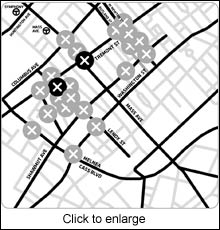Over the Past six months, Boston has seen an average of one shooting a day — a level not reached since the early ’90s
 It’s now clear: We have returned to the wild west of the early 1990s.
It’s now clear: We have returned to the wild west of the early 1990s.
In Boston, one gunshot victim every other day is the norm; one every day is a crisis. From 1990 through 1995 — the bad years, when gun violence ruled the streets of Boston — the city averaged 440 shooting victims a year (fatal and nonfatal), or 1.2 a day. Then came the Boston Miracle. The shootings decreased dramatically, averaging over the next nine years 190 annually, or 0.5 a day.
But for the past six months, since the start of September 2005, we have been back over the one-a-day mark for the first time since 1994, the Phoenix has learned. Nearly 200 people were shot — 30 fatally — during those six months, according to information provided by the Boston Police Department. More than half of the 197 victims were age 20 or younger; 26 of them — that’s one a week — were younger than 17. More than 90 percent of the incidents took place in Roxbury, Dorchester, Mattapan, the South End, and Jamaica Plain. The shootings didn’t all occur in the dead of night, either: about a quarter happened during the day, between 6 am and 6 pm, and a third in the early evening, between 6 and 10 pm.
And most of these shooting happened during the usually quiet winter months. Individuals in Codman Square, Uphams Corner, Roxbury Crossing, Grove Hall, Mattapan Square, and Lenox Street in the South End have all expressed to the Phoenix their fear that when the weather warms up and people return outdoors, the violence will get even worse. We got a taste of that two weekends ago, when the first warm patch of spring brought with it a dozen shooting victims in three days.
As one Dorchester resident put it, “It’s gonna blow up.”
Fierce loyalty
What does it do to, say, a 15-year-old boy when people get shot in his neighborhood on a regular basis?
David Harding wondered that. Starting in 2003, Harding, a researcher at University of Michigan’s Population Studies Center who received his PhD in sociology and social policy from Harvard, interviewed 60 adolescents in the troubled Boston neighborhoods of the South End and Franklin Hill, as well as their families, community leaders, ministers, youth workers, and police.
His report
, published three months ago, is eye-popping, and it rings true to what this reporter has seen and heard.
“The daily threat of being victimized affected, on a daily basis, where they went, who they associated with, and the strength of those associations,” Harding told the Phoenix of the boys he interviewed. Although he doesn’t put it this way in the report, surviving certain parts of Boston these days is an awful lot like surviving prison: you must develop certain strategies, such as acting tough and even violent to convince people you are not an easy target; making alliances or joining a gang for protection; avoiding behavior — like snitching — that will provoke someone’s wrath; finding a way to arm yourself for self-defense.
In particular, Harding saw that these kids (now in their late teens and early 20s) are forced into a fierce loyalty to their micro-neighborhood, often a housing development or a single street. And if you’re stuck in the middle of a conflict with people who have demonstrated a perfect willingness to put bullets into other people, you’re going to want friends to help you when you need it. Everybody’s fight becomes your fight.
This is the way life is for several-hundred young men who live in the South End neighborhood Harding studied: the quarter-mile-by-half-mile stretch between Tremont and Washington Streets, and between West Newton Street and Melnea Cass Boulevard.
In just the past six months, 23 people have been shot on this patch of land not much bigger than Boston Common and the Public Garden combined. Within this tiny area, the battle lines are drawn between the housing developments Lenox/Camden, “1850 Washington” (a/k/a Grant Manor), West Newton Street, Cathedral, West Concord, and Mandela Homes.
In a recent federal-court decision, Judge Nancy Gertner compared Boston’s “gang” conflicts with the ethnic divisions in New York when she was growing up there in the 1950s. The comparison is apt, although ethnicity plays less a role among Boston’s street youth than loyalty to one’s street or housing project. And just as an Italian American at that time couldn’t simply opt out and expect to feel safe in other neighborhoods, residents of the South End’s Lenox Street development, for example, are part of the conflict with 1850 Washington — whether they want to be or not.
By no means are all, or even most, of the neighborhood’s residents violent. But the presence of the few creates a culture that affects and sucks in many more. And the same thing is happening, with similar escalations of gun violence, in Grove Hall, on Franklin Hill, on Dudley Street, near Egleston Square, on Hamilton Street, around Walk Hill Street and Blue Hill Avenue, and elsewhere.